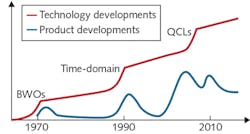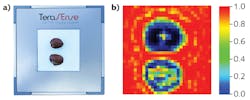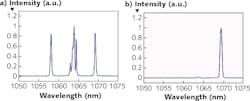Advances in Imaging: Terahertz imaging - A technology in search of applications
VIACHESLAV M. MURAVEV, GOMBO E. TSYDYNZHAPOV, IGOR V. KUKUSHKIN, IAN MCNEE, and VLADIMIR G. KOZLOV
The first advances in terahertz sources, operating at frequencies of 0.1 to 3.0 THz and corresponding to a wavelength range of 3.0 to 0.1 mm, date back to the 1970s. These were vacuum electronic devices called backward wave oscillators (BWOs), producing up to 100 mW of power at 0.1–0.3 THz and up to 1 mW at higher frequencies. Although more compact and reliable solid-state terahertz electronic devices developed in the 1990s deliver similar performance now, reaching higher power levels remains a challenge.
Development of time-domain terahertz technology based on generation of terahertz waves by ultrafast lasers created the second round of excitement about the potential of terahertz imaging in the 1990s. Images of skin cancer produced by this method set up high expectations for the use of terahertz technology in medical applications, but progress has remained slow, as strong absorption of terahertz waves by water limits their penetration depth in tissue to 1 mm at most. And time-domain terahertz imaging requires raster scanning of samples since data is acquired one pixel at the time—another challenge for real-time diagnostics.
Video-rate terahertz imaging enabled by microbolometer detector arrays developed by INO (Québec City, QC, Canada) and NEC (Tokyo, Japan) around 2005 caused the next wave of excitement in terahertz imaging technologies. Terahertz microbolometer cameras leveraged technology developed for the mid-infrared (mid-IR) spectral range, but improved the sensitivity of these devices at lower frequencies, reaching down to 1 THz.
Development of terahertz sources using quantum cascade lasers (QCLs) by extending the performance of mid-IR QCLs to the terahertz range also occurred around 2005, and seemed to be perfect for microbolometer terahertz cameras in terms of spectral range. But even though a combination of these devices delivered a viable solution for video-rate terahertz imaging with sufficiently high contrast at frequencies above 2.8 THz with higher-power cryogenically cooled QCLs, the problem is that the transmission of a majority of materials deteriorates at such high frequencies and, again, water absorption becomes very strong.
The high cost of QCLs and cryogenic cooling has hampered applications development, even as terahertz technology advances. And like any other photonics technology, development activity in terahertz imaging has fluctuated, with current levels of product development being modest (see Fig. 1).
In 2015, one of the leading suppliers of time-domain terahertz systems—Zomega Terahertz (Troy, NY)—discontinued operations, and other vendors reduced their staffing levels. However, this situation is improving.
Terahertz to the rescue
Opportunities for terahertz product developers have often coincided with disasters. The first one was the tragic events of September 11, 2001. Potential applications of terahertz imagers for airport security scanners attracted a lot of government funding in 2002-2010, but high-frequency microwave imaging technology emerged as the winner in that race.
Many airports are now equipped with millimeter-wave scanners that use 20–30 GHz (15–10 mm wavelength) sources and detectors to produce three-dimensional (3D) images of passengers revealing hidden objects. The next generation of these scanners is likely to use 80–90 GHz technology, reaching closer to the terahertz range. Use of millimeter-wave technology in wireless communications, a much larger market, has helped to bring more investment for technology development and reduce the cost of products.
A second event of note was the Space Shuttle Columbia disaster of 2003 that was linked to defects in the adhesion of thermal insulating foam to the body of the spacecraft. Terahertz imaging was brought in as one of the diagnostic tools by NASA to ensure safety on the missions that followed. Cost was not an issue in this project and Picometrix (Roanoke, VA; now a division of Luna) delivered several time-domain scanners to NASA. Foam is very transparent in the terahertz range and in this case, terahertz imaging was a viable complementary technology to x-ray and ultrasound imagers.
While companies developing time-domain terahertz imaging systems have had more success in applications for industrial process and product quality controls, competition from x-ray and ultrasound imaging is fierce. More-established technologies tend to win on price and reliability. And even though terahertz systems often deliver better performance, customers tend to settle for more proven methods and are unwilling to take a risk by dealing with a new technology.
Disasters aside, demand for terahertz imaging for agricultural and industrial applications seems to be picking up. Progress in technology development also remains steady. Two new approaches for video-rate imaging include two-dimensional (2D) arrays of plasmonic detectors and upconversion of terahertz images to the near-infrared (near-IR) region, revealing an unseen world that eludes other spectral bands.
Plasmonic detectors and upconversion imaging
Recent progress in the purity of semiconductor aluminum gallium arsenide/gallium arsenide (AlGaAs/GaAs) nanostructures has made it possible to adapt the plasmonic concepts from the optical region of the spectrum to the microwave and terahertz bands. Unfortunately, standard 2D plasmons are observable only when their frequency is ω > 1/τ, where the momentum relaxation time τ essentially decreases with increasing temperature. Hence, the plasmonic effects are visible only at sufficiently large frequencies and sufficiently low temperatures.1
Indeed, 2D plasma waves at frequencies attractive for applications where f < 500 GHz have been observed only at cryogenic temperatures T < 80 K.2 This fact severely impedes the advance of terahertz applications for plasmonic electronics.
One way to circumvent this imposed limitation is to deal with relativistic plasma excitations-the novel type of plasma waves discovered recently in a gated 2D electron system.3 These weakly damped plasma waves are excited in a high-conductivity 2πσ > c (where σ is two-dimensional conductivity in Gaussian units) electron system and possess a strong polaritonic nature. It was proven that such relativistic plasmons survive up to room temperature in the microwave and sub-terahertz frequency ranges.
In the TeraSense detector, terahertz radiation is converted into the alternating potential of a relativistic plasma wave via a broadband antenna structure deposited onto the crystal surface. Moreover, the alternating potential of the plasma wave is rectified to yield the measured photoresponse signal, owing to the asymmetry of the plasmonic waveguide. The geometry of the detector can be chosen to match a specific terahertz frequency band.
TeraSense has developed 2D arrays of such detectors that enable 4096-pixel cameras. Using 100 GHz compact IMPATT-diode generators with an output power up to 100 mW as an illumination source, these terahertz cameras can identify carcinogenic Mycotoxin fungus contaminating peanuts, corn, and other grain crops and oil plants. In another application, terahertz images show signs of a fungus in hazelnuts known as Aspergillus flavus and Aspergillus parasiticus, which exude an extremely dangerous carcinogen, Aflatoxin B1 (see Fig. 2).An alternative terahertz imaging method involves upconversion of terahertz images to higher-frequency near-IR light. Upconversion and detection of these images with a charge-coupled device (CCD) camera was first demonstrated more than 20 years ago using broadband terahertz pulses generated by femtosecond lasers.4
Terahertz images were upconverted by mixing laser and terahertz pulses in a nonlinear crystal to generate an orthogonally polarized signal at the laser wavelength by the electro-optic effect. Since this signal is proportional to the terahertz field, an image encoded in the terahertz beam can be transferred to the laser's wavelength. Detecting this image requires filtering out the laser beam at its original polarization, which was accomplished by polarization filters. The contrast of these images was not great, but it was the first demonstration of the concept.
High-power narrowband sources of terahertz waves (up to 3 mW of average power at 1.5 THz) developed by Microtech have enabled significant improvements in the contrast of images produced in a similar process.5, 6
Mixing of narrowband picosecond lasers and terahertz pulses in a nonlinear crystal produces spectral sidebands on both sides of the laser line (see Fig. 3). A notch filter is used to attenuate the background at 1064 nm and sidebands corresponding to ωpump + ωTHz (at 1058 nm) and ωpump- ωTHz (at 1070 nm) are observed. Replacing the notch filter by a long-pass filter almost completely removes the pump (and the shorter-wavelength sideband), leaving the sideband at 1070 nm. Spectral sidebands were also orthogonally polarized in this experiment.This upconverted signal can be used for transferring images from terahertz beams to the near-IR. This is accomplished by placing objects in a collimated terahertz beam, then focusing and mixing it with a near-IR laser beam in a nonlinear crystal. Filtered sidebands in the laser beam carry the image, which is detected with CCD and CMOS cameras.
A combination of spectral and polarization filtering has resulted in very high-contrast images and videos. Examples of terahertz movies made using this method are available at http://mtinstruments.com/movies/leafpptvideo.mp4; http://mtinstruments.com/movies/envelopepptvideo.mp4; and http://mtinstruments.com/movies/teflonvids.mp4.
Spectral separation of the sidebands is defined by the terahertz frequency, which was 1.5 THz in the 1070 nm sideband experiment. This imaging method can be extended to lower terahertz frequencies—potentially even to 100–300 GHz—by using narrower-spectrum lasers and filters. Higher-power terahertz sources available at these lower frequencies will lead to further improvements in the image contrast, and increase demand for terahertz imaging systems in a variety of emerging applications.
REFERENCES
1. I. V. Andreev et al., Appl. Phys. Lett., 105, 202106 (2014).
2. W. Knap et al., J. Infrared Millim. Terahertz Waves, 30, 1319 (2009).
3. V. M. Muravev et al., Phys. Rev. Lett., 114, 106805 (2015).
4. Q. Wu et al., Appl. Phys. Lett., 69, 1026–1028 (1996).
5. P. Tekavec et al., "Terahertz generation from quasi-phase matched gallium arsenide using a type II ring cavity optical parametric oscillator," Proc. SPIE, 8261, 82610V (Feb. 9, 2012).
6. P. Tekavec et al., "Video rate THz imaging based on frequency upconversion using a near-IR CMOS camera," Proc. CLEO 2014, STh4F.7 (2014).
Viacheslav M. Muravev is vice president, Gombo E. Tsydynzhapov is senior engineer, and Igor V. Kukushkin is president, all at TeraSense Group, San Jose, CA, http://terasense.com, while Ian Mcnee is an applications engineer and Vladimir G. Kozlov is founder and CEO, both at Microtech Instruments, Eugene, OR; e-mail: [email protected]; www.mtinstruments.com.


